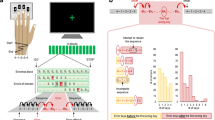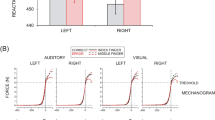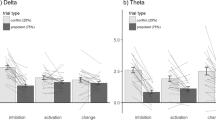Abstract
We used measures of the human event-related brain potential (ERP) to investigate the neural mechanisms underlying error processing during action observation. Participants took part in two conditions, a task execution condition and a task observation condition. We found that activity in both the medial frontal cortex and the motor cortices, as measured via the error-related negativity and the lateralized readiness potential, respectively, was modulated by the correctness of observed behavior. These data suggest that similar neural mechanisms are involved in monitoring one's own actions and the actions of others.
This is a preview of subscription content, access via your institution
Access options
Subscribe to this journal
Receive 12 print issues and online access
$209.00 per year
only $17.42 per issue
Buy this article
- Purchase on Springer Link
- Instant access to full article PDF
Prices may be subject to local taxes which are calculated during checkout




Similar content being viewed by others
References
Falkenstein, M., Hohnsbein, J., Hoormann, J. & Blanke, L. Effects of errors in choice reaction tasks on the ERP under focused and divided attention. in Psychophysiological Brain Research (eds. Brunia, C., Gaillard, A. & Kok, A.) 192–195 (Tilburg Univ. Press, Tilburg, The Netherlands, 1990).
Gehring, W.J., Goss, B., Coles, M.G.H., Meyer, D.E. & Donchin, E. A neural system for error detection and compensation. Psychol. Sci. 4, 385–390 (1993).
Miltner, W.H.R., Braun, C.H. & Coles, M.G.H. Event-related brain potentials following incorrect feedback in a time-estimation task. Evidence for a “generic” neural system for error detection. J. Cogn. Neurosci. 9, 788–798 (1997).
Dehaene, S., Posner, M.I. & Tucker, D.M. Localization of a neural system for error detection and compensation. Psychol. Sci. 5, 303–305 (1994).
Carter, C.S. et al. Anterior cingulate cortex, error detection, and the online monitoring of performance. Science 280, 747–749 (1998).
Kiehl, K.A., Liddle, P.F. & Hopfinger, J.B. Error processing and the rostral anterior cingulate. Psychophysiology 37, 216–223 (2000).
Ullsperger, M. & Von Cramon, D.Y. Subprocesses of performance monitoring: A dissociation of error processing and response competition revealed by event-related fMRI and ERPs. NeuroImage 14, 1387–1401 (2001).
Ullsperger, M. & Von Cramon, D.Y. Error monitoring using external feedback: Specific roles of the habenular complex, the reward system, and the cingulate motor area revealed by functional magnetic resonance imaging. J. Neurosci. 23, 4308–4314 (2003).
Posner, M.I. & DiGirolamo, G.J. Executive attention: conflict, target detection, and cognitive control. in The Attentive Brain (ed. Parasuraman, R.) 401–423 (The MIT Press, Cambridge, Massachusetts, 1998).
Paus, T. Primate anterior cingulate cortex: where motor control, drive and cognition interface. Nat. Rev. Neurosci. 2, 417–424 (2001).
Hadland, K.A., Rushworth, M.F.S., Gaffan, D. & Passingham, R.E. The anterior cingulate and the reward-guided selection of actions. J. Neurophysiol. 89, 1161–1164 (2003).
Matsumoto, K., Suzuki, W. & Tanaka, K. Neuronal correlates of goal-based motor selection in the prefrontal cortex. Science 301, 229–232 (2003).
Holroyd, C.B., Nieuwenhuis, S., Mars, R.B. & Coles, M.G.H. Anterior cingulate cortex, selection for action, and error processing. in Cognitive Neuroscience of Attention (ed. Posner, M.I.) (Guilford Publications, New York, in press).
Shima, K. & Tanji, J. Role for cingulate motor area cells in voluntary movement selection based on reward. Science 282, 1335–1338 (1998).
Bush, G. et al. Dorsal anterior cingulate cortex: a role in reward-based decision making. Proc. Natl. Acad. Sci. USA 99, 523–528 (2002).
Holroyd, C.B. & Coles, M.G.H. The neural basis of error processing: reinforcement learning, dopamine, and the error-related negativity. Psychol. Rev. 109, 679–709 (2002).
Piaget, J. Play, Dreams and Imitation in Childhood (Norton Library, New York, 1962).
Tomasello, M., Kruger, A.C. & Ratner, H.H. Cultural learning. Behav. Brain Sci. 16, 495–552 (1993).
Petrosini, L. et al. Watch how to do it! New advances in learning by observation. Brain Res. Rev. 42, 252–264 (2003).
Blandin, Y. & Proteau, L. On the cognitive basis of observational learning: development of mechanisms for the detection and correction of errors. Q. J. Exp. Psychol. Hum. Exp. Psychol. 53A, 846–867 (2000).
Flanagan, J.R. & Johansson, R. Action plans used in action observation. Nature 424, 769–771 (2003).
Iacoboni, M. et al. Cortical mechanisms of human imitation. Science 286, 2526–2528 (2001).
Hari, R. et al. Activation of human primary motor cortex during action observation: a neuromagnetic study. Proc. Natl. Acad. Sci. USA 95, 15061–15065 (1998).
Rizzolatti, G., Fogassi, L. & Gallese, V. Neurophysiological mechanisms underlying the understanding and imitation of action. Nat. Rev. Neurosci. 2, 661–670 (2001).
Miltner, W.H.R., Brauer, J., Hecht, H., Trippe, R. & Coles, M.G.H. Parallel brain activity for self-generated and observed errors. in Errors, Conflicts, and the Brain. Current Opinions on Performance Monitoring (eds. Ullsperger, M. & Falkenstein, M.) 124–129 (MPI of Cognitive Neuroscience, Leipzig, 2004).
Coles, M.G.H. Modern mind-brain reading: psychophysiology, physiology, and cognition. Psychophysiology 26, 251–269 (1989).
Leuthold, H. & Jentzsch, I. Distinguishing neural sources of movement preparation and execution. An electrophysiological analysis. Biol. Psychol. 60, 173–198 (2002).
Eriksen, B.A. & Eriksen, C.W. Effects of noise letters upon the identification of a target letter in a non-search task. Percept. Psychophys. 16, 143–149 (1974).
Holroyd, C.B. A note on the oddball N200 and the feedback ERN. in Errors, Conflicts, and the Brain. Current Opinions on Performance Monitoring (eds. Ullsperger, M. & Falkenstein, M.) 211–218 (MPI of Cognitive Neuroscience, Leipzig, 2004).
Babiloni, C. et al. Human cortical electroencephalography (EEG) rhythms during the observation of simple aimless movements: a high-resolution EEG study. NeuroImage 17, 559–572 (2002).
Decety, J. & Grezes, J. Neural mechanisms subserving the perception of human actions. Trends. Cogn. Sci. 3, 172–178 (1999).
Maeda, F., Kleiner-Fisman, G. & Pascual-Leone, A. Motor facilitation while observing hand actions: specificity of the effect and role of observer's orientation. J. Neurophysiol. 87, 1329–1335 (2002).
Bekkering, H., Wohlschläger, A. & Gattis, M. Imitation of actions in children is goal-directed. Q. J. Exp. Psychol. 53A, 153–164 (2000).
Baldissera, F., Cavallari, P., Craighero, L. & Fadiga, L. Modulation of spinal excitability during observation of hand actions in humans. Eur. J. Neurosci. 13, 190–194 (2001).
Nieuwenhuis, S., Yeung, N., Van den Wildenberg, W. & Ridderinkhof, K.R. Electrophysiological correlates of anterior cingulate function in a go/no-go task: effects of response conflict and trial-type frequency. Cogn. Affect. Beh. Neurosci. 3, 17–26, (2003).
Miller, J., Coles, M.G.H. & Chakraborty, S. Dissociation between behavioural and psychophysiological measures of response preparation. Acta Psychol. 94, 189–208 (1996).
Gratton, G., Coles, M.G.H. & Donchin, E. A new method for off-line removal of ocular artifact. Electroencephalogr. Clin. Neurophysiol. 55, 468–484 (1983).
Coles, M.G.H., Scheffers, M.K. & Holroyd, C.B. Why is there an ERN/Ne on correct trials? Response representations, stimulus-related components, and the theory of error-processing. Biol. Psychol. 56, 173–189 (2001).
Wasserman, S. & Bockenholt, U. Bootstrapping: Applications to psychophysiology. Psychophysiology 26, 208–221 (1989).
Scherg, M. & Berg, P. BESA-Brain Electric Source Analysis Handbook (Max-Planck Institute for Psychiatry, Munich, 1996).
Acknowledgements
We thank P. de Water and N. Hermesdorf for help in constructing the joysticks and LED-device, and K. Roze, A. Peijnenborgh and C. van den Brom for their assistance in data collection. H.T.v.S. and H.B. were supported by the European Science Foundation (IST-2000-29689).
Author information
Authors and Affiliations
Corresponding author
Ethics declarations
Competing interests
The authors declare no competing financial interests.
Supplementary information
Rights and permissions
About this article
Cite this article
van Schie, H., Mars, R., Coles, M. et al. Modulation of activity in medial frontal and motor cortices during error observation. Nat Neurosci 7, 549–554 (2004). https://doi.org/10.1038/nn1239
Received:
Accepted:
Published:
Issue Date:
DOI: https://doi.org/10.1038/nn1239
This article is cited by
-
Perceived authenticity across three forms of educational simulations—the role of interactant representation, task alignment, and continuity of simulation
European Journal of Psychology of Education (2024)
-
Combined EEG and immersive virtual reality unveil dopaminergic modulation of error monitoring in Parkinson’s Disease
npj Parkinson's Disease (2023)
-
Mechanisms for mutual support in motor interactions
Scientific Reports (2021)
-
Review of brain encoding and decoding mechanisms for EEG-based brain–computer interface
Cognitive Neurodynamics (2021)
-
The anterior midcingulate cortex might be a neuronal substrate for the ideomotor mechanism
Experimental Brain Research (2021)



